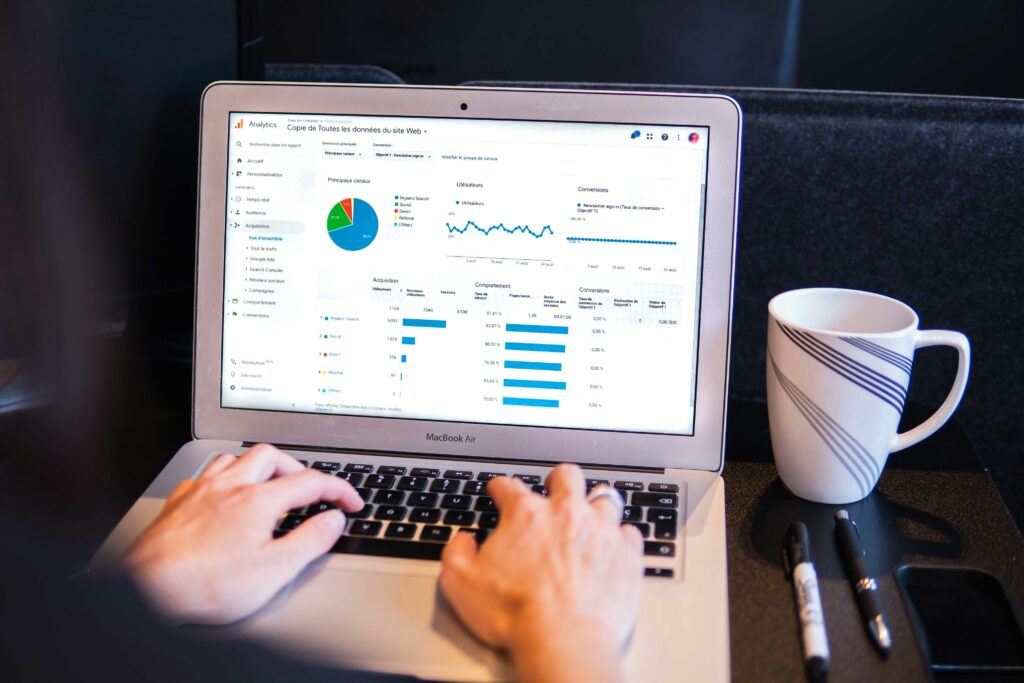- The Good News
- Improving SEO Changes the Game
- 1. Optimize Title Tags & Meta Descriptions for Maximum Clicks
- 2. Ensure a Mobile-Friendly Website Design for Better Rankings
- 3. Clean Up Technical SEO Issues to Strengthen Your Site
- 4. Create Location Pages to Boost Local SEO
- 5. Track & Analyze SEO Performance Using Google Analytics and Search Console
- Take Your SEO Strategy to the Next Level
- FAQ’s
Your website is often the first impression potential customers have of your business, and if they find it largely depends on your SEO strategy. Search engines evaluate hundreds of ranking factors before deciding which pages to display for a given query. These factors include site structure, mobile usability, page speed, content relevance, technical performance, and user engagement. Even small improvements in any of these areas can significantly enhance your site’s visibility, traffic, and conversions, ultimately improving SEO results for your business.
In 2025, SEO is not just about stuffing pages with keywords. It is about creating a seamless experience for users, answering their questions efficiently, and building trust and authority online. With a few strategic adjustments, any website, regardless of size, can see measurable improvements in search rankings, boosting your local ranking and helping your business appear in local search results. Focusing on ways to improve SEO consistently over time ensures your website reaches the right audience and generates measurable results.
The Good News
The good news is that you can improve SEO on your website without a complete redesign or a huge budget. Thoughtful, strategic adjustments can quickly boost search rankings, attract more visitors, and make your website work harder for your business.
Even small tweaks, like updating meta descriptions, improving mobile usability, performing keyword research, or adding structured data, can have a major impact over time. SEO is cumulative: small wins compound into measurable results. By learning how to improve SEO in targeted ways, businesses can see both short-term gains and long-term growth.
In this guide, we will explore five actionable ways to instantly improve SEO, with examples, pro tips, videos, and resources to help your team implement each strategy effectively. By focusing on the right adjustments, you can ensure your site engages your target audience, improves rankings, and delivers measurable results while supporting your local SEO strategy.
Improving SEO Changes the Game
Imagine a small local bakery struggling to attract customers despite having the best pastries in town. Their website existed, but few people ever found it online. Walk-in traffic was slow, and phone orders were minimal.
After implementing a few targeted SEO strategies, optimizing their meta descriptions, improving mobile usability, performing keyword research to target high-intent searches, and responding to customer reviews, the bakery started appearing at the top of search results for queries like “fresh pastries near me” and “best croissants in [City].” Within weeks:
- Website traffic surged
- Phone orders increased
- Social media engagement grew
- The shop quickly became a neighborhood favorite
This story shows just how powerful SEO can be. The right adjustments do not just improve search rankings; they directly impact real business results, connecting the right target audience with your products or services at the right time, improving SEO performance, boosting local search results, and generating measurable business results.
1. Optimize Title Tags & Meta Descriptions for Maximum Clicks

Your title tag and meta description are the first elements potential visitors see in search results. Think of them as a digital storefront. Even if your page ranks highly, poorly written titles or descriptions can lead to lost clicks, lower engagement, and reduced results.
Why Title Tags & Meta Descriptions Are Critical
- Boost Click-Through Rate (CTR): Well-crafted titles and meta descriptions can increase CTR, signaling to Google that your page is valuable and relevant.
- Clarify Page Relevance: Search engines rely on your titles and descriptions to understand your content and match it to user queries.
- Enhance Local SEO: Including city names, neighborhoods, or service areas helps your business appear higher in local search results.
Optimized metadata ensures you attract the right audience. Vague or generic descriptions might attract clicks from visitors who are not genuinely interested, increasing bounce rates. Clear, concise, and actionable copy draws visitors more likely to convert into customers and encourages customer reviews and interactions on your website. Learning how to improve SEO through metadata is one of the fastest ways to boost engagement.
Common Mistakes
- Using generic titles like “Home Services” without context
- Keyword stuffing instead of writing naturally
- Repeating meta descriptions across multiple pages
- Failing to include a clear call-to-action (CTA)
Optimization Tips
- Keep meta descriptions under 155 characters
- Use active, action-oriented language
- Naturally include your primary keyword
- Make each page’s meta information unique
- Add a CTA like “Learn more,” “Get started,” or “Book today”
Pro Tip: Optimize your Google Business Profile alongside your website’s meta information. Consistent business information across platforms strengthens your local SEO strategy, improves listings, and boosts visibility in Google Maps and local search results.
Why It Works
Well-crafted title tags and meta descriptions act like a digital storefront, immediately communicating your service, value, and location to potential visitors. Optimizing these elements is about understanding your target audience and writing copy that answers their questions, communicates value, and encourages action. Videos, step-by-step guides, and resources can help your team craft effective meta information efficiently. By prioritizing titles and descriptions, you guide readers to the content that matters most, improving results for your business, supporting your local ranking, and showing how to improve SEO in practical ways.
Practical Example
Instead of:
“Home Services – Smith & Co.”
Use:
“Emergency Plumbing in Salt Lake City | Call Smith & Co. Today”
This version communicates service, location, and value while targeting high-intent searches. Engaging meta descriptions attract readers, establish trust, encourage google reviews, and help convert visitors into customers.
2. Ensure a Mobile-Friendly Website Design for Better Rankings
With mobile-first indexing, Google evaluates the mobile version of your site for ranking. If your site is not optimized for mobile, both your rankings and user engagement can suffer. Most users browse on smartphones or tablets, so mobile usability directly impacts bounce rates, conversions, and local search results.
Why Mobile Optimization Matters
- Improves User Experience: Frustrating mobile navigation drives users away.
- Boosts Local Search Visibility: Mobile searches like “restaurants near me” are increasingly common.
- Increases Conversions: Mobile-friendly sites make it easy for users to call, book, or purchase online.
Optimizing for mobile is about people, not just search engines. A site that adapts to the screen and displays content clearly keeps users engaged, increasing the likelihood of completing actions such as purchases, form submissions, or phone calls, which can help generate more customer reviews over time, improve measurable results, and improve SEO for mobile-first indexing.
Common Mobile SEO Mistakes
- Tiny buttons or hard-to-read text
- Slow-loading pages due to unoptimized images or scripts
- Excessive pop-ups or interstitials
- Poor navigation and cluttered menus
How to Optimize Mobile Usability
- Implement a responsive design that adapts to all screen sizes
- Ensure buttons and menus are large and easy to tap
- Minimize pop-ups and intrusive ads
- Optimize images, scripts, and caching for fast load times
- Test across devices and browsers for consistent performance
Why It Works
A mobile-friendly site ensures your target audience can easily navigate, access information, and complete key actions. Smooth navigation and fast-loading pages reduce bounce rates and increase engagement, signaling search engines that your site is valuable and improving your local ranking while helping you improve SEO overall.
3. Clean Up Technical SEO Issues to Strengthen Your Site

Technical SEO is the foundation for your website’s performance in search engines. Even minor errors can prevent pages from being indexed properly or reduce your ranking potential, limiting results despite great content.
Common Technical Issues
- Broken links (404 errors)
- Redirect loops or chains
- Duplicate content
- Missing alt text on images
- Slow-loading pages
- Poor URL structures
- Missing or outdated XML sitemaps
Why Technical SEO Matters
Technical SEO ensures search engines can crawl and index your content efficiently. A clean, error-free site signals reliability and quality. Poor technical SEO not only impacts search rankings but also frustrates users, lowering engagement and increasing bounce rates. A technically optimized website supports your local SEO strategy, helps listings appear correctly across multiple platforms, ensures measurable results from your SEO efforts, and helps improve SEO across your site.
How to Fix Technical SEO Issues
- Conduct a site audit using tools like Screaming Frog, Ahrefs, or SEMrush
- Fix broken links and redirect errors promptly
- Add missing alt text and optimize images
- Ensure fast load times through caching, compression, and script optimization
- Regularly update and submit your XML sitemap
- Conduct ongoing keyword research to target high-performing terms
- Implement structured data and schema markup to improve SEO for search engines
Why It Works
Fixing technical SEO issues ensures search engines can crawl and index your pages efficiently. Optimized images, proper alt text, and fast load times create a seamless experience for readers, keeping them on your site longer. Using videos, guides, and checklists can help your team identify and fix issues efficiently. Regular maintenance supports long-term results, ensures your content reaches the right audience, improves local search results, increases the likelihood of positive google reviews, and strengthens your ability to improve SEO consistently.
4. Create Location Pages to Boost Local SEO
Dedicated location pages help your business appear in searches relevant to each service area, making it easier for your target audience to find you. Including clear local details, maps, testimonials, and visuals builds trust and authority, answering common questions about your services in each region.
Why Location Pages Matter
- Local Search Visibility: Users searching “roofing in Denver” expect local results.
- Google Maps Integration: Optimized location pages strengthen your Google Business Profile and improve your local ranking.
- Builds Trust & Authority: Local testimonials, project details, and visuals increase credibility and encourage customer reviews.
What Each Location Page Should Include
- City or region name in headings and content
- NAP (Name, Address, Phone number) consistent with Google Business Profile
- Local testimonials or project examples
- Embedded Google Maps
- Local business schema markup
Why It Works
Creating dedicated location pages clarifies where your business operates, helping search engines and visitors find relevant services. Including local details, maps, testimonials, and visuals engages your target audience, answers common questions, and encourages actions like phone calls or bookings. Videos showcasing projects, team members, or local events can further enhance engagement, keeping visitors on the page longer, improving local search results, generating more reviews to boost your local ranking, and helping improve SEO for each targeted area. Conducting keyword research for each location ensures pages target the terms your customers are actively searching for.

5. Track & Analyze SEO Performance Using Google Analytics and Search Console
SEO is an ongoing process, and tracking performance is critical for measuring results and guiding improvements. Tools like Google Analytics and Search Console provide insights into traffic, user behavior, keyword performance, and conversions.
Why Tracking SEO Works
Monitoring your website allows you to answer key questions, such as:
- Which pages engage visitors the most?
- Where do users drop off?
- Which keywords drive high-quality traffic?
- Are technical issues impacting performance?
Insights from Analytics and Search Console guide data-driven improvements to content, meta information, and technical SEO. Videos, tutorials, and step-by-step resources can help teams understand how to interpret the data. Regular tracking ensures your website continuously delivers measurable results, improves engagement, grows visibility for your target audience over time, supports your local SEO strategy, boosts local search results, and helps improve SEO through actionable insights.
Take Your SEO Strategy to the Next Level
To take your SEO strategy even further, consider leveraging resources like the Green House Sales and Marketing ebook https://fertilizer.thegreenhouseuvu.com/seo_ebook, which outlines key SEO topics and actionable strategies to help your business grow online.
By using the tools recommended in the ebook, you can gather the right information to track your website’s performance, answer key questions, and improve results. Integrating insights from Google Search Console ensures you understand exactly how your pages are performing in search, where improvements will have the biggest impact, and how to improve SEO across all areas of your site.
This combination of expert guidance, actionable tools, and real-time data makes optimizing your website more efficient and effective, helping you generate measurable business results, increase google reviews, grow your presence in local search results, and improve SEO consistently over time.
FAQ’s
1. What is SEO and why should I try to improve SEO on my website?
SEO, or search engine optimization, is the process of optimizing your website so that search engines like Google, Bing, and Yahoo can better understand your content and rank it higher in search results. Improving SEO is crucial because higher rankings increase the likelihood that potential customers or readers will find your website when searching for relevant topics, products, or services.
Strong SEO not only helps your website appear in search results but also builds credibility and trust with your audience, making it easier to convert visitors into loyal customers. A strong local SEO strategy helps your business appear in local search results and attract more positive customer reviews.
2. How can I improve SEO for better search engine rankings?
Improving SEO requires a combination of strategies that target different aspects of your website. Start by:
- Optimizing website content with relevant keywords, headings, and high-quality images
- Writing meta titles and descriptions that accurately describe your pages and include key search terms
- Fixing technical SEO issues like slow page speed, mobile responsiveness, secure HTTPS setup, and structured data
- Building backlinks from authoritative websites
A consistent, well-rounded SEO strategy helps your pages rank higher, attract more qualified visitors, and provide a better user experience that keeps people coming back. It also strengthens local search results, encourages more google reviews, and helps improve SEO continuously for your website.
3. Does improving SEO impact my website’s visibility in search results?
Yes. Enhancing your SEO directly affects how visible your website is to search engine users. When you optimize your site’s content, structure, and technical elements, search engines can better understand what your website offers and when it should appear in search results. Improved visibility also boosts credibility, as users are more likely to trust websites that appear at the top of search results. Over time, consistent SEO efforts create lasting growth, helping your website attract people actively searching for the products or information you provide. This growth also supports your local SEO strategy and encourages positive customer reviews across multiple listings while helping improve SEO in all targeted areas.


